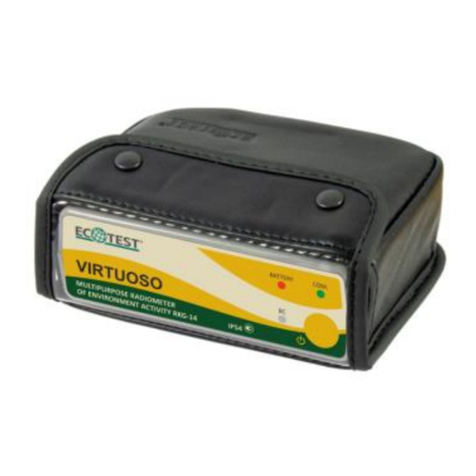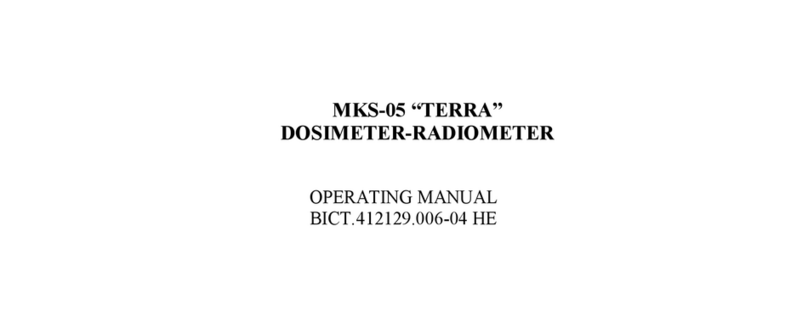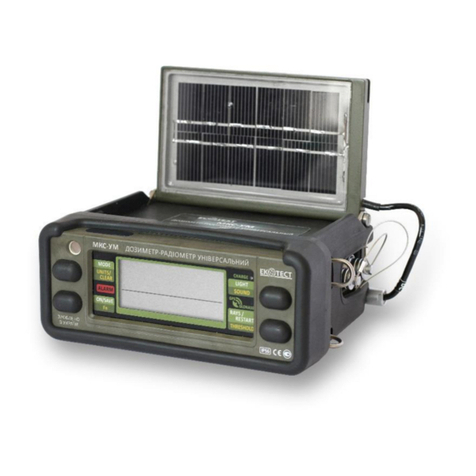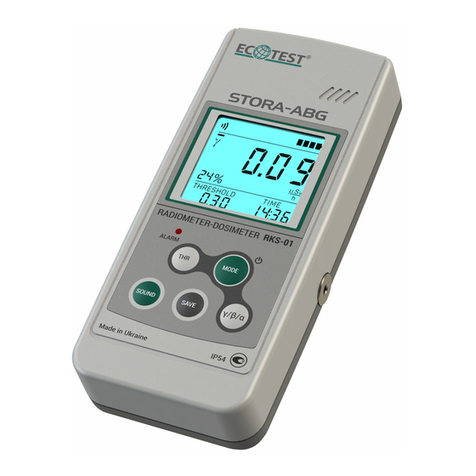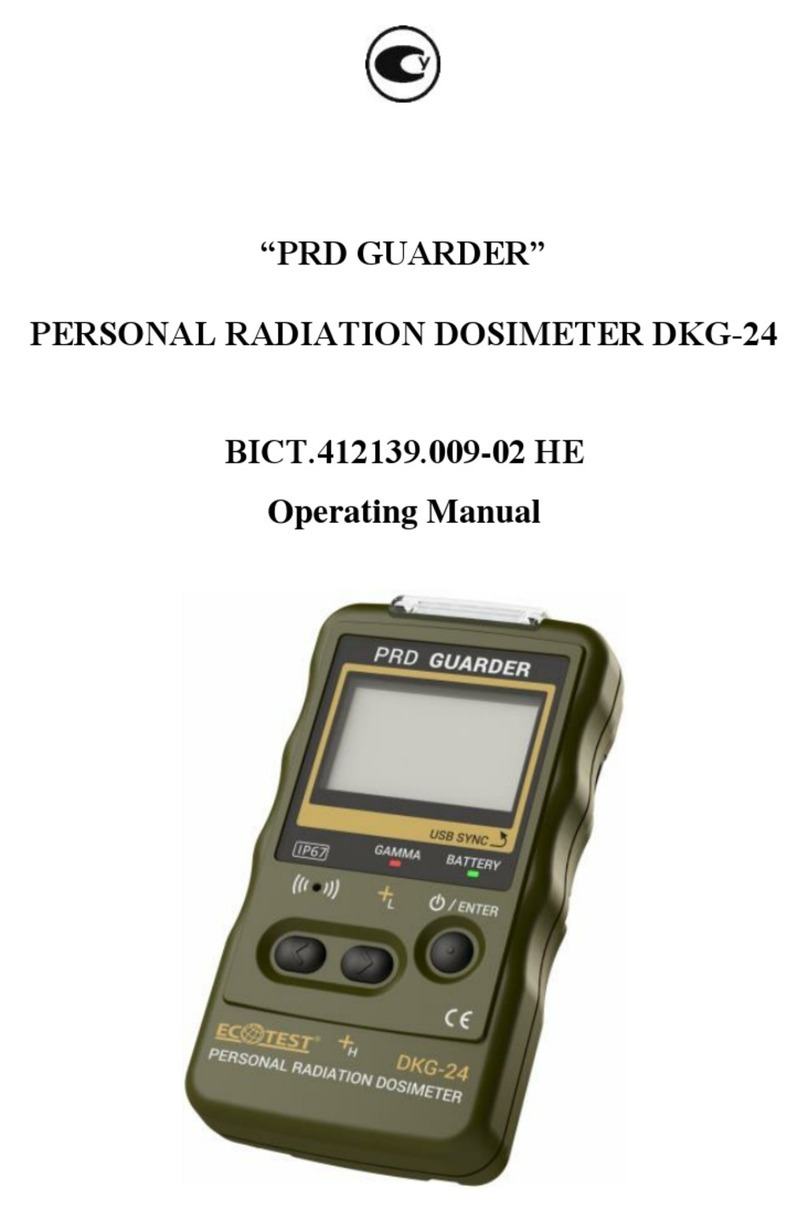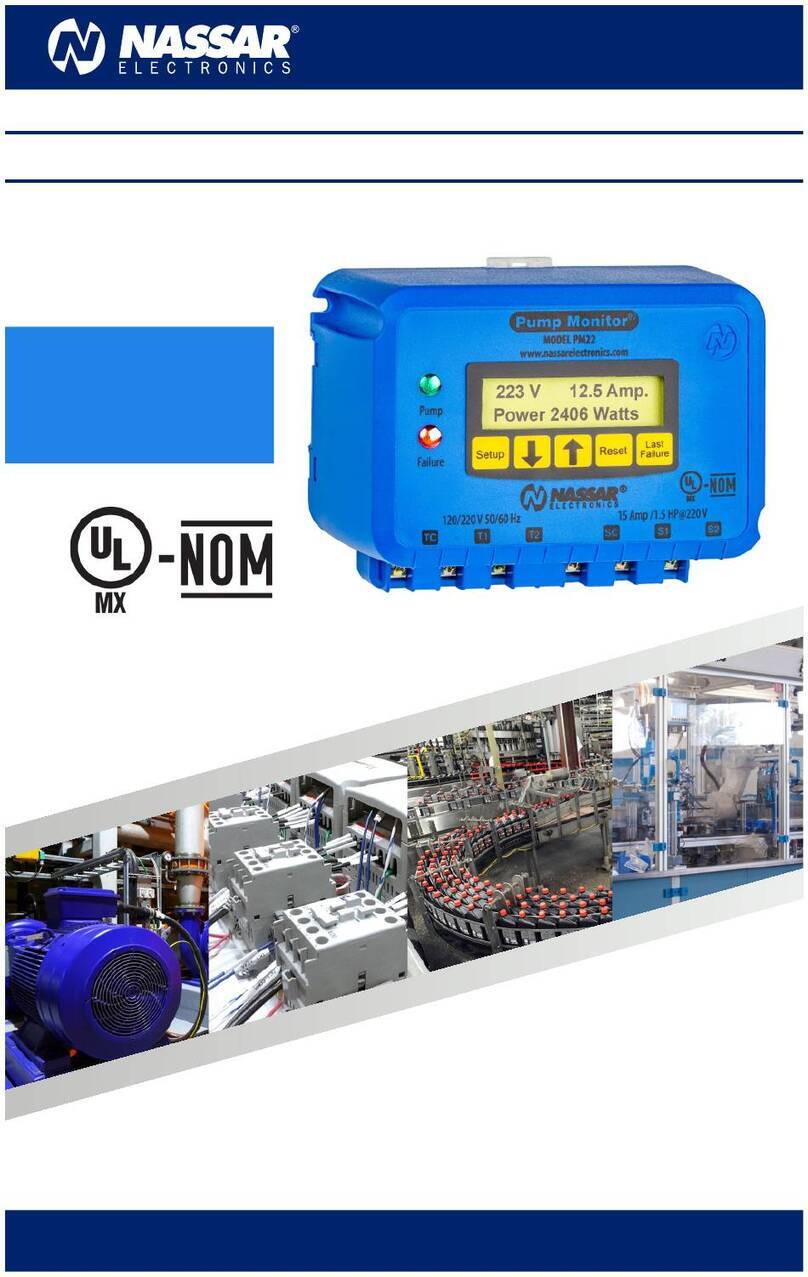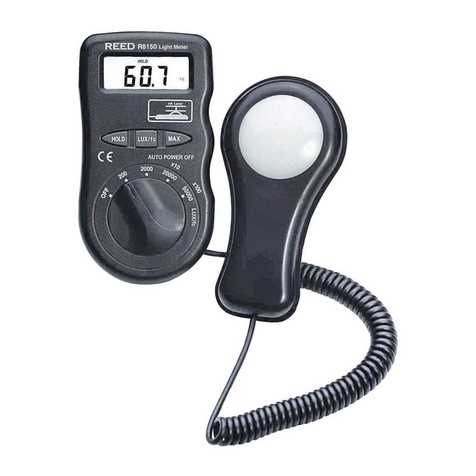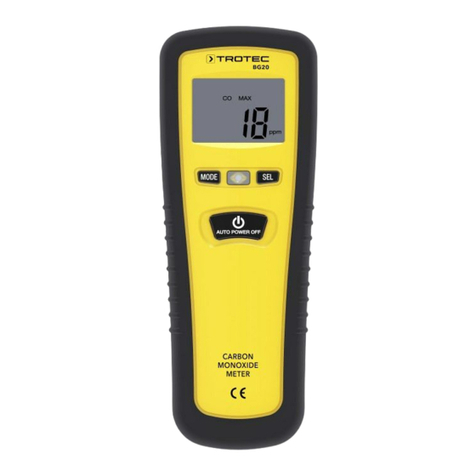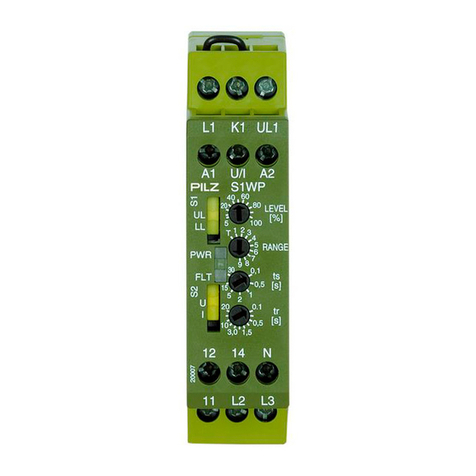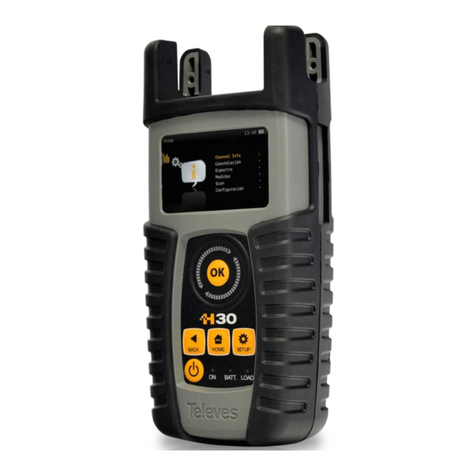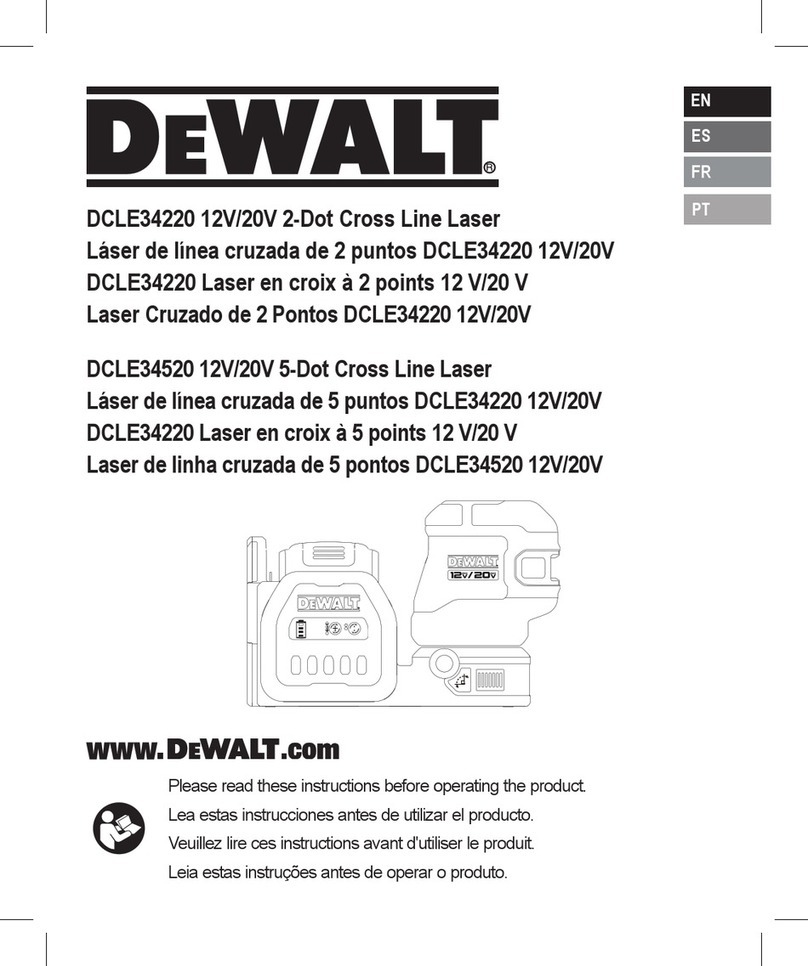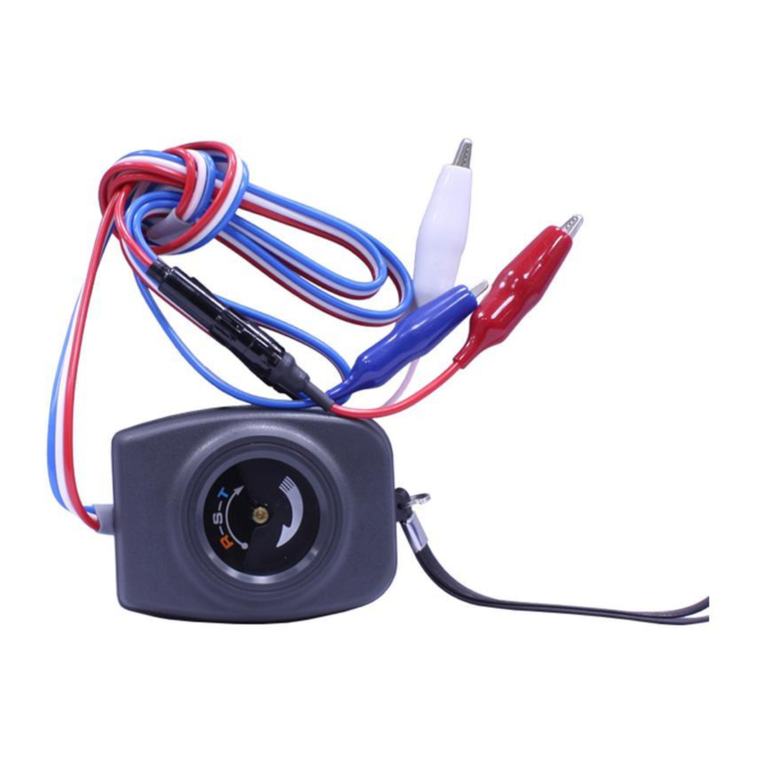ECOTEST SPECTRA MKS-11GN User manual

MKS-11GN “SPECTRA”
SEARCH DOSIMETER-RADIOMETER
Operating Manual


2
CONTENTS
1 DESCRIPTION AND OPERATION............................................. 4
1.1 PURPOSE OF USE....................................................................... 4
1.2 TECHNICAL SPECIFICATIONS .................................................... 5
1.3 DELIVERY KIT OF THE DEVICE................................................ 13
1.4 DESIGN AND PRINCIPLE OF OPERATION................................... 14
1.5 LABELING AND SEALING......................................................... 17
1.6 PACKING ................................................................................ 17
2 PROPER USE OF THE DEVICE................................................ 18
2.1 OPERATING LIMITATIONS ....................................................... 18
2.2 PREPARATION FOR OPERATION............................................... 18
2.3 USE OF THE DEVICE ................................................................ 19
3 TECHNICAL MAINTENANCE................................................. 71
3.1 TECHNICAL MAINTENANCE OF THE DEVICE ............................ 71
3.2 VERIFICATION OF THE DEVICE................................................ 73
4 CERTIFICATE OF ACCEPTANCE ............................................ 82
5 PACKING CERTIFICATE........................................................... 82
6 WARRANTY ............................................................................... 83
7 REPAIR ........................................................................................ 84
8 STORAGE ................................................................................... 85
9 SHIPPING.................................................................................... 85
10 DISPOSAL................................................................................. 86
APPENDIX А ................................................................................. 87
APPENDIX B ................................................................................. 88
APPENDIX C ................................................................................. 89
APPENDIX D ................................................................................. 90
APPENDIX E.................................................................................. 91
APPENDIX F.................................................................................. 92

3
This Operating Manual (hereinafter called the OM) is intended to
inform the user about the principles of operation and rules of
application of the search dosimeter-radiometer MKS-11GN
“SPECTRA”. The manual contains all information necessary for full
implementation of its technical capabilities and its proper use.
The MKS-11 “SPECTRA” search dosimeter-radiometer is
designed in the following modifications:
- MKS-11 G “SPECTRA” is designed to measure the ambient
dose equivalent rate of gamma and X-rays, the ambient dose
equivalent of gamma and X-rays, and identify gamma radionuclides
for their amplitude spectra;
- MKS -11 GN “SPECTRA” is intended to measure gamma and
X-rays DER, the ambient equivalent dose of gamma and X-rays,
identify gamma radionuclides for their amplitude spectra, and
determine the intensity of neutron radiation.
The OM contains the following abbreviations:
DER - ambient dose equivalent rate of gamma and X-ray
radiation (further –photon-ionizing radiation);
DE - ambient dose equivalent of gamma and X-ray radiation
(further –photon-ionizing radiation);
SGDU - scintillation detecting unit of photon-ionizing
radiation;
GMC - Geiger-Muller counter;
SNDU - scintillation neutron detecting unit;
PC - personal computer.

4
1 DESCRIPTION AND OPERATION
1.1 Purpose of use
MKS-11GN “SPECTRA” search dosimeter-radiometer
(hereinafter –dosimeter) is referred to spectrometer-type devices and
designed to:
•Measure DER of photon-ionizing radiation;
•Measure DE of photon-ionizing radiation;
•Display DER of neutron radiation;
•Determine gamma and neutron radiation intensity;
•Identify the type of radionuclides by their amplitude gamma
spectra;
•Store amplitude gamma spectra and events in the
nonvolatile memory.
The device is designed under ANSI N42.48-2008.
The device is used to detect and localize radioactive and nuclear
materials by gamma and neutron radiation so as to prevent their
illicit transfer, and at enterprises and organizations that deal with
sources of gamma and neutron radiation.
The device is employed in the following areas:
• Customs and Border Services;
• Law enforcement agencies (MIA, Security Service of Ukraine,
safeguard services);
• Vehicles monitoring, seaports, and airports;
• Environmental inspections;
• Radioactive waste disposals.

5
1.2 Technical specifications
1.2.1 Key specifications are presented in Table 1.1.
Table 1.1
Name
Measure-
ment unit
Standardized
value
Total measurement and
display range of photon-
ionizing DER:
From built-in:
-SGDU
-GMC
μSv/h
0.01…106
0.01 to 50
50 to 106
Measurement and display
range of photon-ionizing
DE from the GMC
μSv
0.1…9.9·106
Display range of neutron
radiation DER
μSv/h
0.01 … 104
Display range of count rate
of photon-ionizing radiation
cps
1 … 25000
Display range of pulse count
rate of neutron radiation
from the SNDU
cps
0.01 … 25000
Main relative permissible
error limit when measuring
photon-ionizing radiation
DER from the SGDU at
0.95 confidence probability
(137Cs)
%
15+1/H*(10),
where H*(10)
is a numeric
value of
measured
DER in μSv/h

6
Table 1.1 (continued)
Name
Measure-
ment unit
Standardized
value
Main relative permissible error
limit when measuring photon-
ionizing radiation DER and DE
from the GMC at 0.95
confidence probability (137Cs)
%
15
Energy range of registered
photon-ionizing radiation
MeV
0.02 … 3.00
Energy dependence of the
device’s readings when
measuring photon-ionizing
radiation DER in the energy
range from 0.05 MeV to
1.25 MeV relative to
0.662 MeV energy (137Cs)
%
±25
Anisotropy of the detectors
SGDU and GMC at incidence of
gamma quanta at angles from
+60о to –60оhorizontally and
vertically relative to the main
measurement direction, marked
by “+”:
- for 137Cs and 60Со isotopes
- for 241Am isotopes
%
30
75
Number of channels of
amplitude gamma spectrum
channel
2048
Resolution of SGDU for 137Cs,
not more than
%
8
Energy range of registered
neutron radiation
eV
0.025 … 14·106
Set-up time of the device
operation, not more than
min
1

7
Table 1.1 (continued)
Name
Measure-
ment unit
Standardized
value
Calibration time by the level
of gamma background
s
2 … 90
Response time to over
10 times change of photon-
ionizing radiation DER
s
0.25
Operating supply voltage of
the device from a lithium-
polymer battery
V
3.7
Continuous operation of the
device when powered from the
freshly-charged battery under
background of gamma
radiation not more than
0.5 μSv/h:
- a switched-off display
backlight, with no alarm
triggering and a switched-off
navigation receiver, not less
than
- a switched-off display
backlight, with no alarm
triggering and a switched-on
navigation receiver, not less
than
h
200
55
Operating temperature range
°С
–20 … +50
Dimensions of the device
with no clip (the clip
included), not more than
mm
67×127×30 (45)
Weight of the device, not
more than
kg
0.28

8
1.2.2 The photon-ionizing radiation sensitivity of (137Cs) CsI(Tl)
scintillation detector is at least 200 (cps)/(µSv/h).
Note.At the request of the user, the sensitivity can be changed to a value
ofnotlessthan450(cps)/(μSv/h).
The neutron radiation sensitivity while using the LiI(Eu)
scintillation detector is equal to:
- At least 1.2 ± 0.12 (pulse×cm2)/n for thermal neutrons;
- At least 0.12 ± 0.012 (pulse×cm2)/n for fast neutrons.
1.2.3 The device features a threshold alarm system with four
independent threshold levels:
- Search threshold level or a sigma-threshold (a threshold level of
pulse count rate from the detector of photon-ionizing radiation);
- Safety threshold level (a threshold level of gamma radiation
DER);
- Neutron threshold level (a threshold level of count rate from the
neutron detector);
- Accumulated dose threshold level (a threshold level of photon-
ionizing DE).
1.2.4 The search threshold level is calculated automatically by
the device in the mode of calibration by the gamma background
intensity level and consists of the background counting rate and the
preset number of rms deviations of background counting rate.
Calibration time by the level of gamma background intensity ranges
from 2 to 90 s.
The adjustable range of the number of rms deviations is from 1 to
9.9. Programming resolution –0.1. The device notifies on exceeding
of the search threshold level with light (red), vibration, or sound
signals "Sigma threshold exceeding". Any combination of alarms
is possible, while at least one type must remain. On the screen of the
device appears a corresponding icon that duplicates the alarm.

9
1.2.5 The safety threshold level is adjusted in the format
XXX.YY in µSv/h or mSv/h. The minimum safety threshold level
may not be less than 0.3 µSv/h.
The device notifies on exceeding of this threshold level with light
(red), vibration, or sound signals "Safety threshold exceeding".
Any combination of alarms is possible, while at least one type must
remain. On the screen of the device appears a corresponding icon
that duplicates the alarm.
1.2.6 The conditional threshold alarm level by a neutron channel
is set with the values from 1 to 9, where 1 is the highest sensitivity of
the device to neutron radiation (but also the greatest probability of
false positives), and 9 is the lowest sensitivity and lowest probability
of false positives. Programming resolution –1. The device notifies
on exceeding of this threshold level with light (blue), vibration, or
sound signals "Neutron threshold exceeding". Any combination of
alarms is possible, while at least one type must remain. On the screen
of the device appears a corresponding icon that duplicates the alarm.
1.2.7 Threshold level by the accumulated dose is adjusted in the
XXX.Y format in µSv/h and mSv/h, and in the X.YYY format in Sv.
While the DE threshold level can be set to 0, the alarm on exceeding
the DE threshold level will be turned off. Otherwise, when the DE
threshold level is surpassed, the device notifies by a light (red),
vibration, or a sound signal “Accumulated dose threshold
exceeding”. On the screen of the device appears a corresponding
icon that duplicates the alarm.
1.2.8. The device’s threshold alarm on exceeding of the search
threshold level triggers no later than in 2 s after the level of photon-
ionizing radiation increases above the background value (with
photon-ionizing DER level of 0.1 µSv/h) to the DER level of 0.5
µSv/h for a maximum time of 0.5 s.

10
1.2.9 The false alarm rate for photon-ionizing radiation and
neutron rays is not more than 1 per 10 hours of operation in a stable
background environment and at the following values of threshold
levels:
- Search –5;
- Safety –1 µSv/h;
- Neutron –5.
1.2.10 The device does not give false signals about the presence
of neutron radiation when exposed to photon-ionizing radiation from
60Со or 137Cs source at DER value of up to 100 µSv/h.
1.2.11 The device can automatically record event log files in the
nonvolatile memory, namely:
- Switch the dosimeter on;
- Switch the dosimeter off;
- Search threshold level being exceeded;
- Safety threshold level being exceeded;
- Conditional threshold level being exceeded in the detector of
neutron radiation;
- Accumulated dose threshold level being exceeded;
- Save measurement by the user’s command;
- Change settings by the administrator;
- Clear the device’s flash memory;
- Identification results.
1.2.12 The nonvolatile memory stores up to 20,000 records of
registered event, as well as 250 full gamma spectra.
1.2.13 The device can identify the following gamma
radionuclides:
•medical radionuclides: 18F, 67Ga, 51Cr, 75Se, 89Sr, 99Mo,
99mTc, 103Pd, 111In, 123I, 125I, 131I, 153Sm, 201Tl, 133Хе;
•industrial radionuclides: 57Co, 60Co, 133Ba, 137Cs, 192Ir,
152Eu, 22Na, 241Am;

11
•special nuclear materials: 233U, 235U, 237Np, 239Pu;
•naturally occurring radioactive materials: 40K, 138La,
226Ra, 232Th
•and decay products, 238U and decay products.
1.2.14 The library can be expanded up to 128 radionuclides via
“Spectra Reader” software in a separate order.
1.2.15 Data communication between the device and the PC is
done via USB.
1.2.16 The device displays signs of the low battery.
1.2.17 The device remains operable under:
- Ambient temperature –20 to +50 °C;
- Relative humidity up to 95 % at 35 °C temperature, non-
condensing;
- Atmospheric pressure from 84 to 106.7 kPa.
1.2.18 The device is tolerant to sinusoidal vibrations by N1 group
according to recommendations of GOST 12997-84 standard.
1.2.19 The device is resistant to single shocks with the following
parameters:
- Shock pulse duration –6 ms
- Maximum shock acceleration –50 m/s2.
1.2.20 The device withstands falls on each of its six edges from a
height of 0.75 m on the concrete floor.
1.2.21 The device remains unaffected by constant and alternating
magnetic field of (50±1) Hz frequency and 400 A/m intensity.
1.2.22 The device is immune to gamma radiation of up to
1.0 Sv/h DER for 50 minutes.
1.2.23 According to GOST 14254-96 standard, the ingress
protection rating of the device is IP67.
1.2.24 The device is resistant to electromagnetic fields of radio-
frequency range in accordance with DSTU IEC 61000-4-3:2007 in
the frequency range from 80 to 1000 MHz at intensity of 10 V/m
(test level 3).

12
1.2.25 The quasi-peak value of the radio interference field
intensity at a distance of 3 m from the device does not surpass the
values for class B equipment according to DSTU EN 55011:2014.
1.2.26 Mean time to failure is not less than 6000 h.
1.2.27 Mean time to full repair is not less than 10 000 h.
1.2.28 The mean service life of the device is at least 10 years
(with the built-in battery being replaced every 5 years).
1.2.29 The average shelf life of the device is at least 10 years
(with the built-in battery being replaced every 5 years).
1.2.30 Mean time to repair of the device, excluding the delivery
time of spare parts, is not more than 3 hours.

13
1.3 Delivery kit of the device
1.3.1 The units and maintenance documentation are included
with the device and presented in Table 1.2.
Table 1.2 –Delivery kit
Item
Type
Q-ty
Note
MKS-11GN
“SPECTRA” search
dosimeter-
radiometer
ВІСТ.412139.006-
02
1
Charging device
1
Model is not
specified
Shielded USB cable
1
Model is not
specified
Operating Manual
ВІСТ.412139.006-
02 HE
1
“Spectra Reader”
software
1
On a mimi-
CD
Case
1
Model is not
specified
Calibration sample*
1
*2 electrodes WT-20 containing 232Th -2 % and of ~408 Bq
activity

14
1.4 Design and principle of operation
1.4.1 General information, design overview
1.4.1.1 External view of the device is shown in Figure 1.
Figure 1 –External view of the device

15
The device is structurally designed as a shape derivative of
rectangular parallelepiped with flat planes being replaced with
surfaces of large radii of curvature with rounded edges. The body is
dustproof, waterproof, made of plastic. The device has upright
working position.
The ingress protection rating is –IP67. The body consists of two
covers (1) and (2) connected by screws. The front cover (1) contains
the graphical color display (3), multifunctional manipulator
(joystick) (4), indicators –GAMMA (7), NEUTRON (8),
BATTERY (9) –and the light sensor ABC (10). In the upper part of
the cover, there is a light display (5) for alarm triggering when
radioactive sources are detected.
A spring clip retainer (11) is secured with one screw on the back
cover, with the help of which the device is securely fastened onto the
operator’s clothes, and which can be easily removed, if necessary.
The back cover and the clip are marked with "+" symbols (12),
which stand for the mechanical centers of photon-ionizing and
neutron radiation detectors, respectively.
On the right lateral surface of the device’s body under the
protective flexible plug (6) there is a USB connector to connect the
peripheral devices and charge the built-in battery.
The device is powered from a lithium-polymer battery of 3.7 V
rated voltage.
The device is sealed with a paste in the indention (13) of the
bottom cover.
1.4.2 Operation of the device
The device consists of the following main parts: high-sensitivity
detecting unit of gamma radiation (GDUh), low-sensitivity detecting
unit of gamma radiation (GDUl), detecting unit of neutron radiation
(NDU), supply voltage formers (SVF), bias voltage formers (BVF),
GPS/GNSS receiver (NAV), display and processing module (DPM),

16
graphical color display (GCD), battery (B), and thermal detector
(TD).
GDUh consists of the detector of CsI(Tl) scintillator type with
silicon photomultiplier and amplifier, while NDU –of the detector of
LiI(Eu) scintillator type with the silicon photomultiplier and
amplifier. GDUl is represented as a Geiger-Muller counter.
The principle of operation of the detecting unit is based on the
transformation of scintillations caused by gamma or neutron
radiation in the scintillator into the voltage pulses in the
semiconductor photomultiplier. These pulses are emanated to the
input of the amplifier where they are intensified and come to the
output as pulses of positive polarity. The number of these pulses is
proportional to gamma or neutron radiation DER, and the amplitude
–to the energy.
For high temperature stability of the detectors with silicon
photomultiplier, DPM constantly compensates temperature by
measuring exact values of temperature at the detectors, and precisely
adjusting the bias voltage.
DPM processes the pulse flow coming from the outputs of
GDUh, GDUl, NDU, and calculates the value of gamma radiation
DER, which corresponds to this flow considering the multichannel
amplitude analysis, and the pulse count rate from GDUh, GDUl, and
NDU.
Depending on the operating mode of the device, the GCD shows
the readings of DER, flux intensity, intensity flow histogram,
statistical error for gamma and neutron channels.
If DER exceeds 50 µSv/h by gamma channel, GDUh is
automatically turned off, and the DER value is calculated from
GDUl that runs continuously.
The DPM consists of the nonvolatile memory, which stores the
event log files, saved gamma spectra, and a library of spectra.

17
1.5 Labeling and sealing
1.5.1 The upper cover and the panel of the device is inscribed
with the name and a symbol of the device, the ingress protection
rating and the manufacturer’s trademark.
1.5.2 The lower cover of the device contains the factory serial
number and the date of manufacture.
1.5.3 Sealing of the device is performed by the manufacturer.
1.5.4 Removal of seals and repeated sealing is performed by the
company after repair and calibration of the device.
1.6 Packing
1.6.1 The device, the charger, and the operating manual are
placed into a dustproof and waterproof case.
1.6.2 The case with the device’s kit is put into a cardboard
packing box, which is glued up on both sides with a plastic film with
a sticky layer.

18
2 PROPER USE OF THE DEVICE
2.1 Operating limitations
Operating limitations are presented in Table 2.1.
Table 2.1 –Operating limitations
Operating limitation
Limitation parameters
1 Ambient air
temperature
from –20 to 50 °С
2 Relative humidity
Up to 100 % at 35 °С temperature,
non-condensing
3 Gamma radiation
exposure
Exposure of photon-ionizing
radiation DER is up to 10 Sv/h during
5 min
2.2 Preparation for operation
2.2.1 Scope and order of external examination
2.2.1.1 Before using the device, unpack it and check if the
delivery kit is complete. Examine for mechanical damages.
2.2.2 Rules and order of examination for operational readiness
2.2.2.1 Read this OM carefully before you start, examine the
location, and find out the intended use of indicators and controls.
2.2.2.2 Charge the battery by connecting the charger to the
USB-port of the device. However, if the device was on, it would
automatically turn off and switch to the charging mode, and the
display would show the battery charging process animation:
.
Note 1. The device is equipped with a lithium-polymer battery
with no "memory effect", which can be charged at any time.
Note 2. Fully charge the battery before the long-term storage of
the device

19
2.2.3 List of possible troubles and troubleshooting
2.2.3.1 The list of possible troubles and troubleshooting is
presented in Table 2.2. Please record the possible troubles in the
table of Appendix A of the Operating Manual.
Table 2.2 –Possible troubles and troubleshooting
Trouble, its manifestation
and additional features
Probable trouble
cause
Troubleshooti
ng
The device does not
switch on
The battery is
discharged
Charge the
battery
No communication
between the device and
the PC
Damaged USB
cable
Replace the
USB cable
The device’s battery does
not charge
1 Damaged USB
cable
2 Charger is out of
order
1 Replace the
USB cable
2 Replace the
charger
2.2.3.2 If you fail to eliminate the troubles listed in Table 2.2 or
locate more complicated troubles, send the device for repair to the
manufacturer.
2.3 Use of the device
2.3.1 Safety measures during use of the device
2.3.1.1 All works on the device use should be carried out
according to the requirements set out in the following documents:
"Radiation Safety Standards of Ukraine" (NRBU-97). State
hygienic standards DHN 6.6.1-6.5.001-98,
"Basic Sanitary Rules of Radiation Safety of Ukraine"
(OSPU-2005) DSP 6.177-2005-09-02.
Table of contents
Other ECOTEST Measuring Instrument manuals
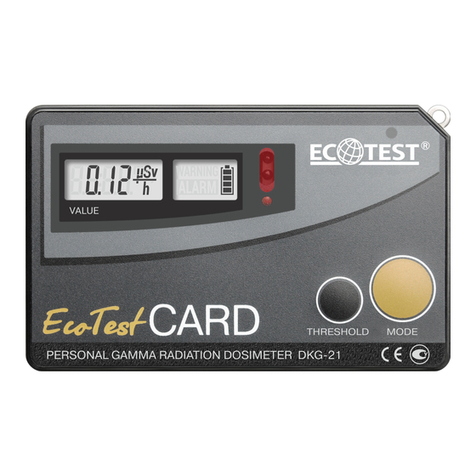
ECOTEST
ECOTEST DKG-21 User manual
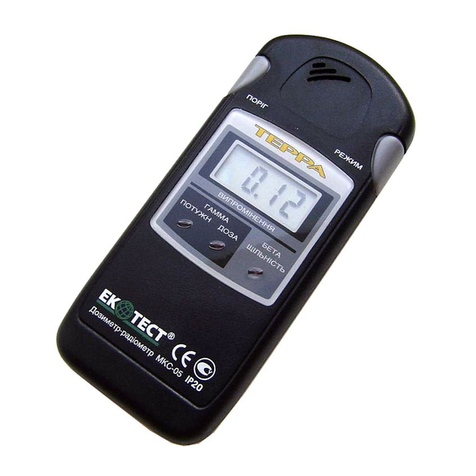
ECOTEST
ECOTEST MKS-05 TERRA-P+ User manual
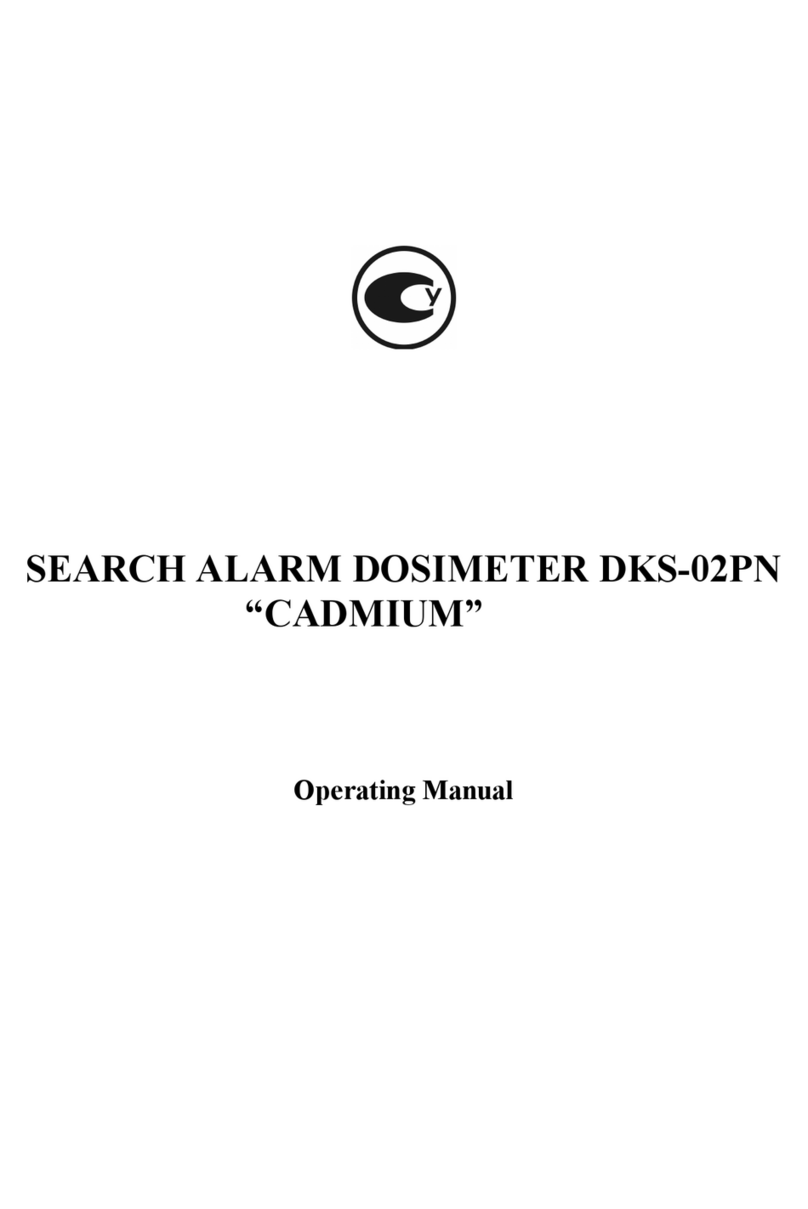
ECOTEST
ECOTEST DKS-02PN User manual

ECOTEST
ECOTEST DKG-21 M User manual

ECOTEST
ECOTEST STORA-TU RKS-01 User manual
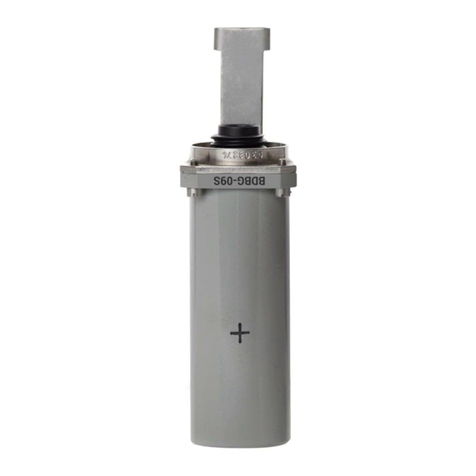
ECOTEST
ECOTEST BDBG-09S User manual
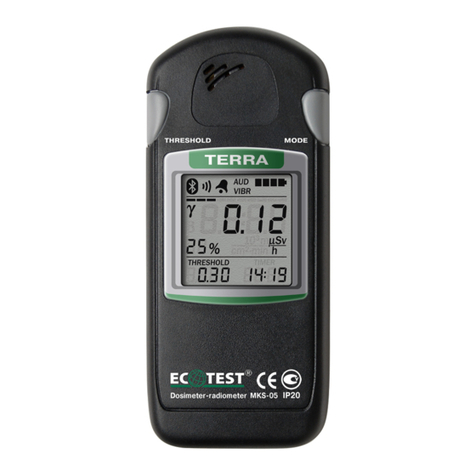
ECOTEST
ECOTEST MKS-05 TERRA User manual

ECOTEST
ECOTEST MKS-05 TERRA-P+ User manual

ECOTEST
ECOTEST DoseG User manual
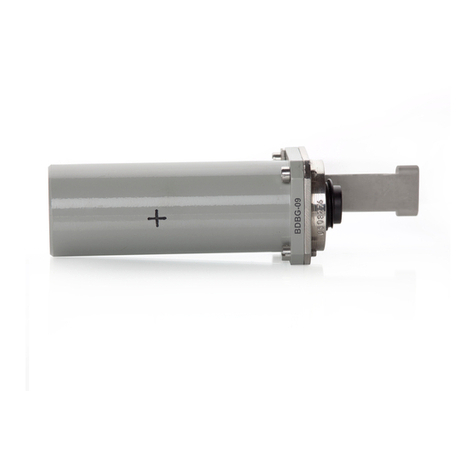
ECOTEST
ECOTEST BDBG-09 User manual
